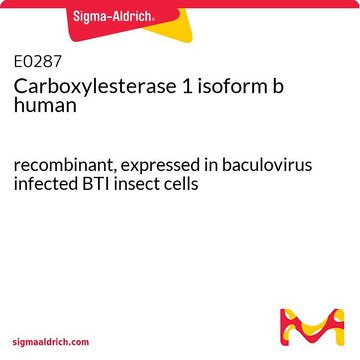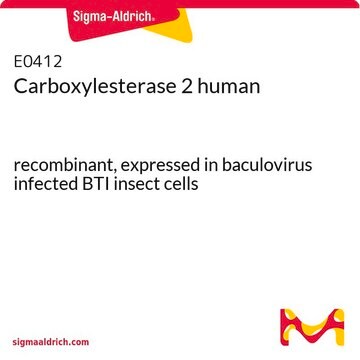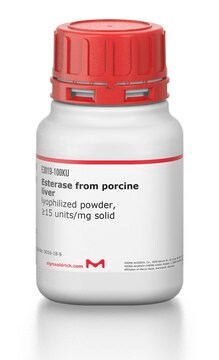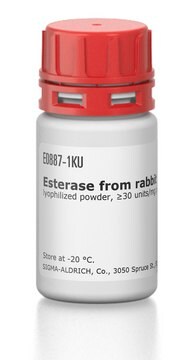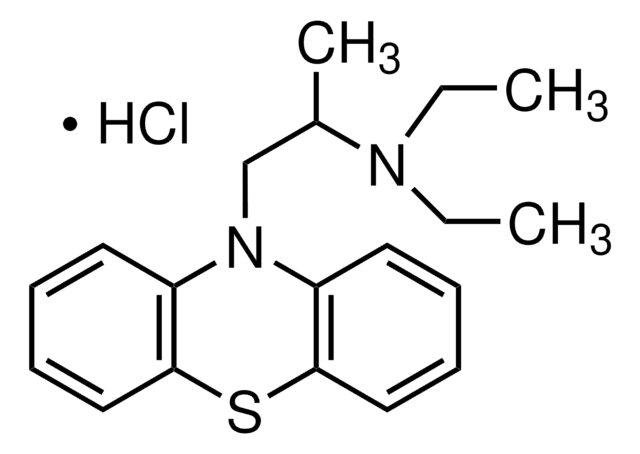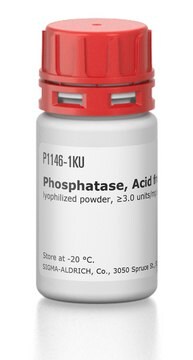Alle Fotos(1)
Wichtige Dokumente
E0162
Carboxylesterase 1 isoform c human
recombinant, expressed in baculovirus infected BTI insect cells
Synonym(e):
Carboxylesterase 1 human, carboxylesterase, esterase
Anmeldenzur Ansicht organisationsspezifischer und vertraglich vereinbarter Preise
Alle Fotos(1)
About This Item
Empfohlene Produkte
Rekombinant
expressed in baculovirus infected BTI insect cells
Qualitätsniveau
Form
liquid
Konzentration
≥0.3 mg/mL
Versandbedingung
dry ice
Lagertemp.
−70°C
Suchen Sie nach ähnlichen Produkten? Aufrufen Leitfaden zum Produktvergleich
Allgemeine Beschreibung
Carboxylesterase 1 (CE1) is a member of a large multigene carboxylesterase α,β-hydrolase family. It is majorly expressed in the liver. CE1 comprises an αβ domain, a central catalytic domain and a regulatory domain.
Anwendung
Carboxylesterase 1 isoform c human has been used as a reference standard in carboxylesterase activity from the mussel for comparison of substrate specificity and inhibition studies. It has also been used as a commercial recombinant protein for the methodological validation of environmental chemical-based inhibition studies.
Biochem./physiol. Wirkung
Carboxylesterase enzymes are responsible for the hydrolysis of ester- and amide-bond-containing drugs such as cocaine and heroin. They also hydrolyze long-chain fatty acid esters and thioesters. Carboxylesterase 1 (CE1) catalyzes the formation of cholesteryl esters from cholesterol and fatty acids. Through a transesterification reaction, CE1 also mediates the generation of fatty acid ethyl esters (FAEEs). It also hydrolyzes aromatic and aliphatic esters with preference to small alcohol groups and bulky acyl groups. CE1 metabolizes drug esters and amides carbamates. It participates in the detoxification of environmental toxicants and carcinogens and is useful in pharmacokinetic studies for evaluating pro-drugs.
Physikalische Eigenschaften
This product is offered in a volume of 0.5 mL.
Einheitendefinition
One unit will hydrolyze one nanomole of 4-nitrophenyl acetate per minute at pH 7.4 at 37 °C.
Signalwort
Danger
H-Sätze
Gefahreneinstufungen
Resp. Sens. 1
Lagerklassenschlüssel
11 - Combustible Solids
WGK
WGK 1
Flammpunkt (°F)
Not applicable
Flammpunkt (°C)
Not applicable
Hier finden Sie alle aktuellen Versionen:
Besitzen Sie dieses Produkt bereits?
In der Dokumentenbibliothek finden Sie die Dokumentation zu den Produkten, die Sie kürzlich erworben haben.
Kunden haben sich ebenfalls angesehen
Montserrat Solé et al.
Environmental toxicology and pharmacology, 82, 103561-103561 (2020-12-12)
Carboxylesterases (CEs) are key enzymes which catalyse the hydrolysis reactions of multiple xenobiotics and endogenous ester moieties. Given their growing interest in the context of marine pollution and biomonitoring, this study focused on the in vitro sensitivity of marine invertebrate
Jihong Lian et al.
Protein & cell, 9(2), 178-195 (2017-07-06)
Mammalian carboxylesterases hydrolyze a wide range of xenobiotic and endogenous compounds, including lipid esters. Physiological functions of carboxylesterases in lipid metabolism and energy homeostasis in vivo have been demonstrated by genetic manipulations and chemical inhibition in mice, and in vitro
Masakiyo Hosokawa
Molecules (Basel, Switzerland), 13(2), 412-431 (2008-02-29)
Mammalian carboxylesterases (CESs) comprise a multigene family whose gene products play important roles in biotransformation of ester- or amide-type prodrugs. They are members of an alpha,beta-hydrolase-fold family and are found in various mammals. It has been suggested that CESs can
Dandan Wang et al.
Acta pharmaceutica Sinica. B, 8(5), 699-712 (2018-09-25)
Mammalian carboxylesterases (CEs) are key enzymes from the serine hydrolase superfamily. In the human body, two predominant carboxylesterases (CES1 and CES2) have been identified and extensively studied over the past decade. These two enzymes play crucial roles in the metabolism
B Sànchez-Nogué et al.
Environmental science and pollution research international, 20(5), 3480-3488 (2012-12-06)
The common sole, Solea solea (Linneus, 1758), and the Senegalese sole, Solea senegalensis (Kaup, 1858), are two important commercial species that coexist in the NW Mediterranean. In order to assess the species' ability to respond to chemical insults, a comparison
Unser Team von Wissenschaftlern verfügt über Erfahrung in allen Forschungsbereichen einschließlich Life Science, Materialwissenschaften, chemischer Synthese, Chromatographie, Analytik und vielen mehr..
Setzen Sie sich mit dem technischen Dienst in Verbindung.